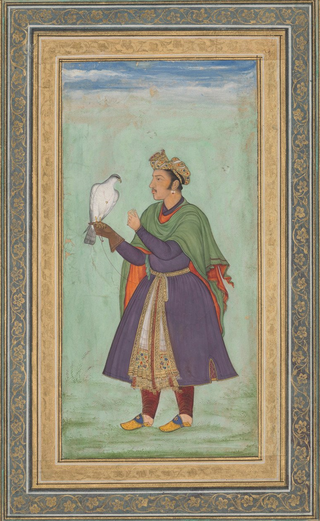Related Research Articles

Gulbadan Begum was a Mughal princess and the daughter of Emperor Babur, the founder of the Mughal Empire.

Khusrau Mirza was the eldest son of the Mughal Emperor Jahangir and his first wife, Shah Begum. The young prince displayed exceptional skills and wisdom and had the privilege to be groomed by the Mughal Emperor (Akbar) himself for the throne of the Mughal Empire. He turned out to be the most capable and qualified son of Jahangir but was befallen by an unfortunate destiny. Being Jahangir's eldest son, he was the heir-apparent to his father but Jahangir favoured his son Khurram Mirza as he held an animosity against Khusrau.

Hamida Banu Begum was the empress consort of the second Mughal emperor Humayun and the mother of his successor, the third Mughal emperor Akbar. She was bestowed the title of Mariam Makani, by her son, Akbar. She also bore the title of Padshah Begum during the reign of Akbar.
Muhammad Zaman Mirza (1496–1539) was a Timurid prince, and general to Mughal Emperors Babur and Humayun. He claimed himself as the ruler of Gujarat in 1537 but did not gain actual control.
Begum is a female title which is also used in Mirza families/lineages, Daughter of Beg or Wife of Beg, a given name and surname.

Murad Mirza was a Mughal prince as the second surviving son of Mughal Emperor Akbar and his mother was a royal concubine. He was raised by Salima Sultan Begum until age of 5. He was the maternal grandfather of Nadira Banu Begum, wife of Prince Dara Shikoh.
Ruqaiya Sultan Begum was the first wife and one of the chief consorts of the third Mughal emperor, Akbar.

Salima Sultan Begum was the third wife and chief consort of the Mughal emperor Akbar, and the granddaughter of Babur.
Bega Begum was Empress consort of the Mughal Empire from 26 December 1530 to 17 May 1540 and 22 February 1555 to 27 January 1556 as the first wife and chief consort of the second Mughal emperor Humayun. She was known as Zan-i-Kalan being the first wife of Humayun and was also known as Haji Begum after she performed the Hajj pilgrimage.

Khanzada Begum was a Timurid princess and the eldest daughter of Umar Shaikh Mirza II, the amir of Ferghana. She was also the elder sister of Babur, the founder of the Mughal Empire. She and her brother remained deeply attached to each other all their lives, a period during which the family progressed from ruling a tiny and obscure principality in Central Asia to ruling a large portion of the Indian subcontinent. Babur conferred on his sister, the honorable title of Padshah Begum and she was really the first lady of his Empire after his death.
Bakshi Banu Begum was a Mughal princess and was the second daughter of Emperor Humayun and his consort Gunwar Bibi. Bakshi Banu was thus the older half-sister of the Mughal Emperor Akbar.
Mah Chuchak Begum was a wife of the second Mughal emperor Humayun. She was an ambitious lady who threw out the Naib Subadar and ruled Kabul on her own, once leading her army in person and defeating Munim Khan at Jalalabad.
Izz-un-Nissa Begum was the third wife of the Mughal emperor Shah Jahan. She is popularly known by the title, Akbarabadi Mahal, and commissioned the Akbarabadi Mosque in Shahjahanabad. Less commonly, she is also referred to as Sirhindi Begum.
Saliha Banu Begum was the chief consort of Emperor Jahangir. She was the Padshah Begum for the most part of the reign of her emperor husband until her death in the year 1620.
Nur-un-Nissa Begum meaning 'Light among Women', was a Timurid princess, the daughter of Ibrahim Husain Mirza and the wife of fourth Mughal emperor Jahangir.

Khas Mahal, meaning "The exquisite one of the palace", was one of the chief wives of the Mughal emperor Jahangir.
Bahar Banu Begum, meaning "The Blooming Lady", was a Mughal princess, the daughter of Mughal emperor Jahangir.
Bakht-un-Nissa Begum was a Mughal princess, the daughter of the Mughal emperor Humayun.
Shakr-un-Nissa Begum, also Shakr al-Nisa Begum was a Mughal princess, the daughter of Emperor Akbar.
Shahzadi Khanam was a Mughal princess, the second surviving child and eldest daughter of Mughal Emperor Akbar.
References
- ↑ Begum, Gulbadan (1902). The History of Humayun (Humayun-Nama). Royal Asiatic Society. p. 186.
- ↑ The Proceedings of the Indian History Congress - Volume 36. Indian History Congress. 1975. p. 169.
- ↑ Awangābādī, Shāhnavāz Khān; Prasad, Baini; Shāhnavāz, 'Abd al-Hayy ibn (1979). The Maāthir-ul-umarā: Being biographies of the Muḥammadan and Hindu officers of the Timurid sovereigns of India from 1500 to about 1780 A.D. Janaki Prakashan. p. 383.
- ↑ Greer, Margaret R.; Mignolo, Wapter D.; Quilligan, Maureen (September 15, 2008). Rereading the Black Legend: The Discourses of Religious and Racial Difference in the Renaissance Empires. University of Chicago Press. p. 62. ISBN 978-0-226-30724-4.
- ↑ Walthall, Anne (2008). Servants of the Dynasty: Palace Women in World History. University of California Press. p. 107. ISBN 978-0-520-25444-2.
- ↑ Beveridge, Henry (1907). Akbarnama of Abu'l-Fazl ibn Mubarak - Volume III. Asiatic Society, Calcuta. p. 1256.